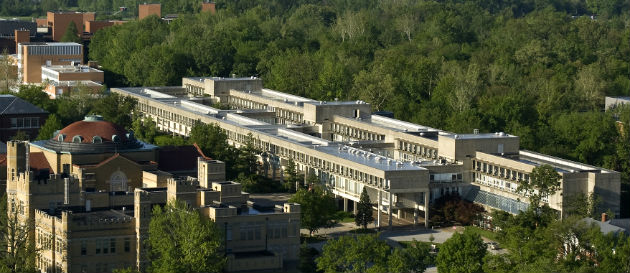There is a building on campus at SIU that is very well known as a maze, a labyrinth. The famous rumor states that you can’t go from one end of the building to the other without going outside, with many twists, turns and steps along the way.
Most easily described as odd, it’s made entirely out of concrete, now worn-down and dark gray in color. Old black streak marks and heavy mold stains can be seen prominently at the top of the building. The structure stands four stories tall and measures 914 feet in length, stretching further than the Titanic. It is the campus divide; in one direction is the newer side of campus, in the other is the historic SIU.
This is Faner Hall: site of conspiracy theories, ghost stories and questionable architecture.
Advertisement
Built in 1974, the structure was originally called the Humanities and Social Services Building, but later had its name changed in honor of respected SIU English teacher of 37 years, Robert Faner. The building is of the brutalist design style. Brutalism architecture, first coming on the scene during the 1950’s, is a style purposefully made to look blocky and rough on the eyes. Generally speaking, Brutalism architecture is made completely out of concrete. Famous architect Robert Geddes designed Faner Hall.
Faner’s offices can be described as “cells” of some sort, as they are compact and small. The initial reaction to the completion of Faner Hall in 1974 wasn’t all that great. Students didn’t care much for the building, and as such, splattered paint on walls. Some streaks remain visible.
Faner was no easy task to complete. During construction, some of the parts for Faner were put together off campus, and then later brought in, because SIU did not have enough room to store the materials.
A tragedy took place on March 6, 1972, when a crane overload resulted in the death of one student while also injuring two others. Some people believe the building is haunted.
There is also the conspiracy theory that Faner Hall was built to be riot-proof. Betty Mitchell, a retired SIU teacher and member of the committee team that helped in the creation of Faner Hall, said the committee never considered the possibility of riots when the plans for Faner were in motion.
Faner Hall today is used in multiple ways, and has a couple notable designations. It is the building in which many students need to complete their core curriculum classes. It is also home to the College of Liberal Arts. Other departments there include criminology and criminal justice, communications studies and Africana studies.
The building has three sections that divide the building, supposedly to make navigation easier. The first section, A-wing, is located closest to the Student Center. A-wing classrooms are labeled in red. B-wing, or the middle section has the College of Liberal Arts located within. Classrooms in this wing are labeled in yellow. C-wing most notably has the university museum, now known as the Sharp Museum.
Advertisement*
Some of the most interesting spots found within Faner are the balconies to nowhere, the stairway to heaven and Dorothy Garden.
The balconies to nowhere are chained and blocked off. The stairway to heaven is a hidden stairway located in the middle of the building, one of those places you have to know even exists before you see it.
Dorothy Garden is considered by many as the most beautiful part of Faner. It is a circular hidden garden with benches, located outside of C-wing. Many see it as a respite from all that ugliness.
Advertisement























